News
- 24/09/2024: A new review, entitled ‘Technological achievements in the fabrication of tubular-designed protonic ceramic electrochemical cells’, has recently been published in the Materials Futures journal (http://dx.doi.org/10.1088/2752-5724/ad7872). This work identifies recent trends and current achievements in the fabrication and characterisation of protonic ceramic electrochemical cells with a tube design. The analysis encompasses a comprehensive range of tubular protonic ceramic devices, including fuel cells, electrolysis cells, sensors, hydrogen pumps, and electrochemical reactors. It begins with the preparation of the powders and ends with an evaluation of their performance.
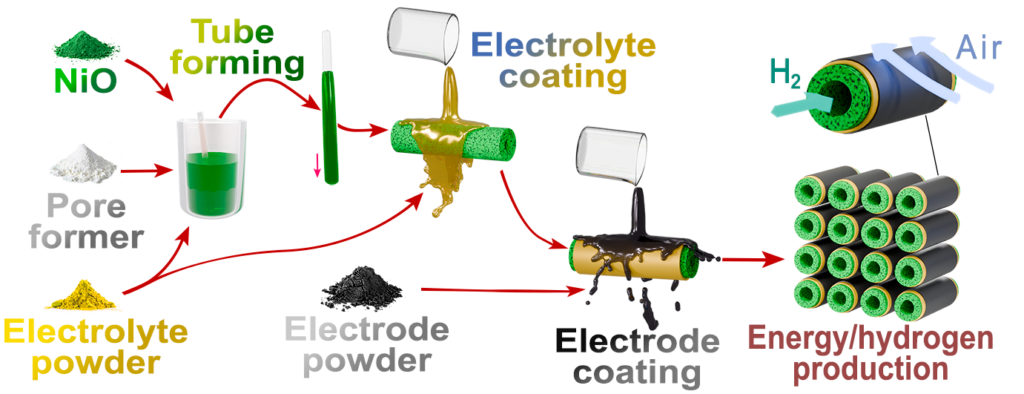
- 03/09/2024: The latest review entitled “Revisiting the ionic conductivity of solid oxide electrolytes. A technical review” has been published in the Journal of Materials Chemistry A (https://doi.org/10.1039/D4TA03852E) in a perspective form.
A critical analysis of the “ionic conductivity” has been conducted, extracting the corresponding literature data for oxygen-ionic or proton-conducting ZrO2, CeO2, LaGaO3, BaCeO3, BaZrO3, and Ba(Ce,Zr)O3 electrolyte families. Such an analysis was performed for both massive ceramic and thin film electrolytes. The results yielded many interesting and unexpected findings, which are presented in detail in the review.
! Note, this review has:
Supplementary information: https://www.rsc.org/suppdata/d4/ta/d4ta03852e/d4ta03852e1.pdf
Transparent peer review: https://www.webofscience.com/api/gateway/wos/peer-review/10.1039/D4TA03852E
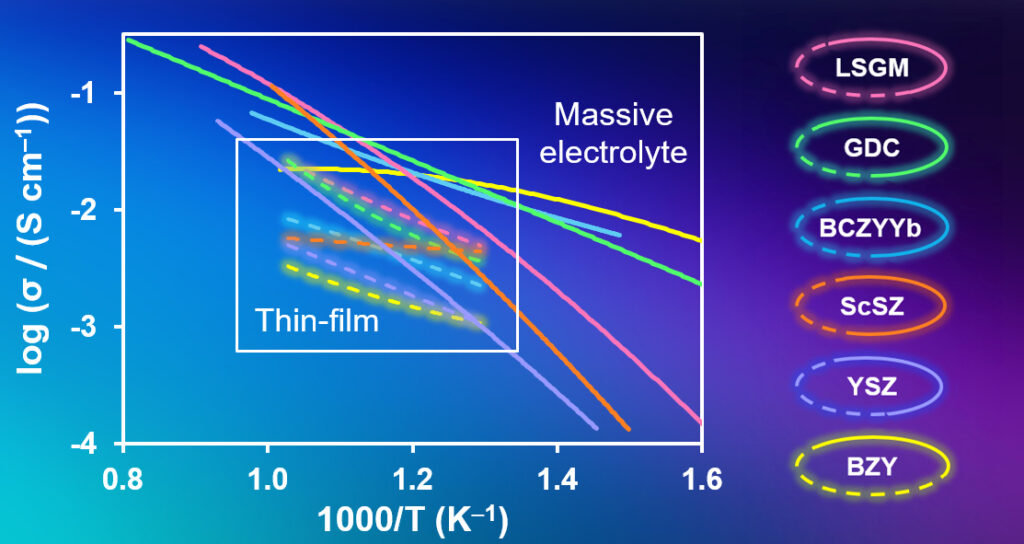
- 05/05/2024: The Journal of Materials Chemistry A (IF = 11.9) has recently published a new article entitled ‘Fundamental and technological aspects of thermochemical expansion of proton-conducting oxides: a case study of BaSn1–xScxO3–δ‘ (https://doi.org/10.1039/D4TA02402H). This work examines the thermal and chemical strains of complex oxides capable of reversible dissociative adsorption of water. It is a well-known phenomenon that when heated, most bodies expand. This is also true when most bodies are heated to 1000 °C. However, there are materials that, when heated, experience not only thermal expansion, but also chemical expansion. In some complex oxides, chemical expansion with increasing temperature is caused by the gradual reduction of cations (for example, Co4+ → Co3+). However, there is another class of complex oxides whose chemical deformation is due to their ability to hydrate/dehydrate. These objects were studied in this study. The aforementioned objects were subjected to investigation through two distinct methodologies, namely high-temperature X-ray diffraction analysis and dilatometry. The data obtained can be employed in two ways: firstly, as technical characteristics in the development of multilayer cells based on BaSn1–xScxO3–δ; and secondly, as fundamental data for the estimation of proton diffusion.
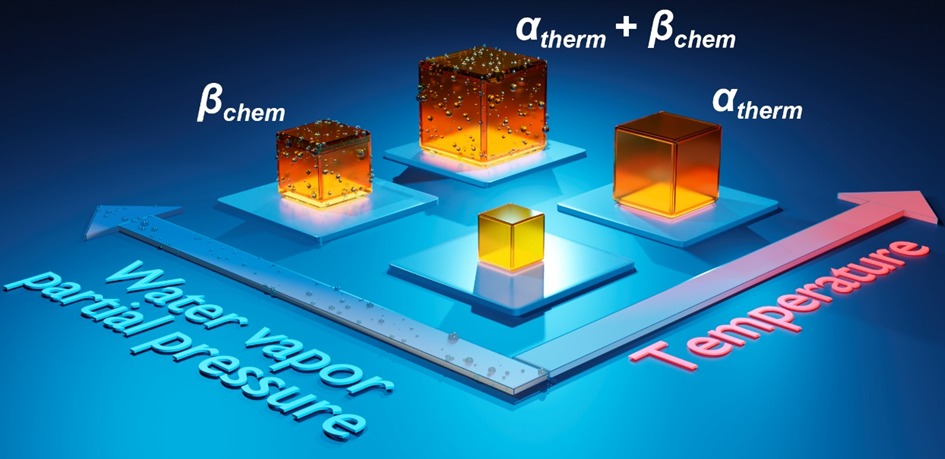
- 05/05/2024: Another BaSnO3-related study has been accepted in the journal of Electrochemical Materials and Technologies (http://elmattech.ru) published by IHTE and UrFU. This work entitled as ‘Co-doping effect on the microstructural and electrical properties of barium stannate materials’ comapes the functional properties of co-doped barium stannates with those of single-doped materials. It is found that the type of dopant affects the materials sinterability, when more coarse-crystalline ceramics are formed with increasing the average ionic radii at the Sn-position. The introduction of Y3+-cations reduces both ionic and hole conductivities compared to single-doped BaSn0.7In0.3O3−δ and BaSn0.7Sc0.3O3−δ materials. However, simultaneous doping with In3+/Sc3+ cations minimizes the contribution of hole conductivity compared to that of Sc-doped barium stannate with the same acceptor dopant concentration.
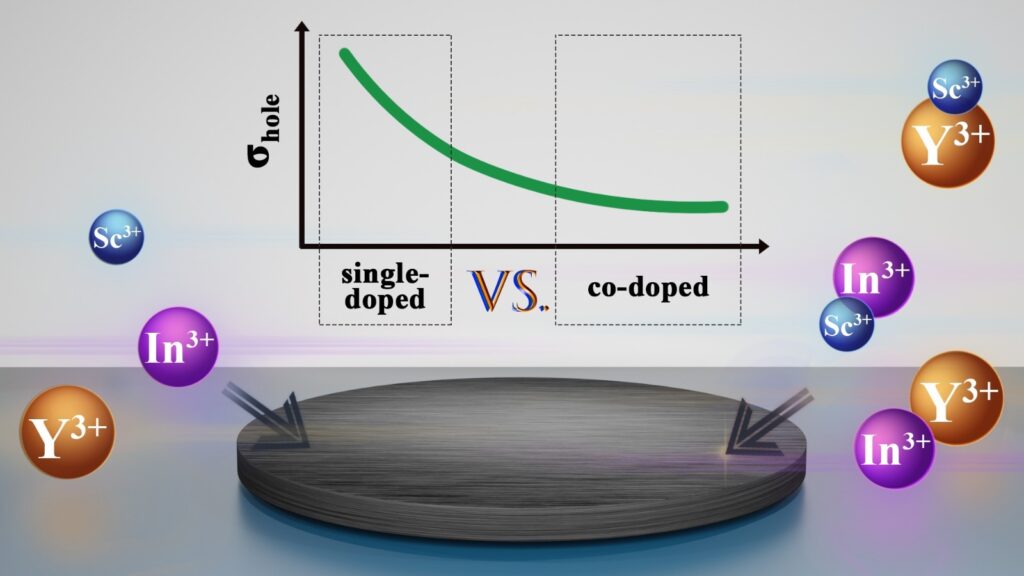
- 05/05/2024: A new research related to barium stannate materials (‘Transport properties of highly dense proton-conducting BaSn1−xInxO3−δ ceramics’) has just been accepted in the International Journal of Hydrogen Energy (IF = 7.2), http://dx.doi.org/10.1016/j.ijhydene.2024.05.012. This work provides useful information regarding structural, microstructural, and electrochemical properties of the BaSn1−xInxO3−δ ceramic materials. Although these materials exhibit many common properties with those of BaSn1−xYxO3−δ and BaSn1−xScxO3−δ studied recently, some features were also revealed. For instance, doped BaSnO3 oxides exhibit mixed ionic-electronic conductivity, with the domination of n-type electronic conductivity in reducing atmospheres or p-type electronic conductivity in oxidizing atmospheres. These trends were maintained even for heavily doped compounds. Other interesting features can be found in this work.

- 24/04/2024: Chemical Engineering Journal (IF = 15.1) has published a new important review entitled ‘Why do BaCo0.4Fe0.4Zr0.1Y0.1O3–δ-derived complex oxides become one of the most promising electrodes for protonic ceramic electrochemical cells? An explanatory review’, https://doi.org/10.1016/j.cej.2024.151615. This review discovers the functional properties and electrochemical performance of origin and doped BaCo0.4Fe0.4Zr0.1Y0.1O3–δ materials as promising ORR and OER electrodes for PCFCs and PCECs. These materials offer unique advantages over widely studied materials, such as La1–xSrxCo1–yFeyO3–δ (known as LSCF), Ba1–xSrxCo1–yFeyO3–δ (BSCF), PrBa1.5Sr0.5Co1.5Fe0.5O6–δ (PBSCF), and Ln2NiO4+δ (LNO). The present review discusses why BaCo0.4Fe0.4Zr0.1Y0.1O3–δ and its doped compositions have garnered increased attention of scientists.
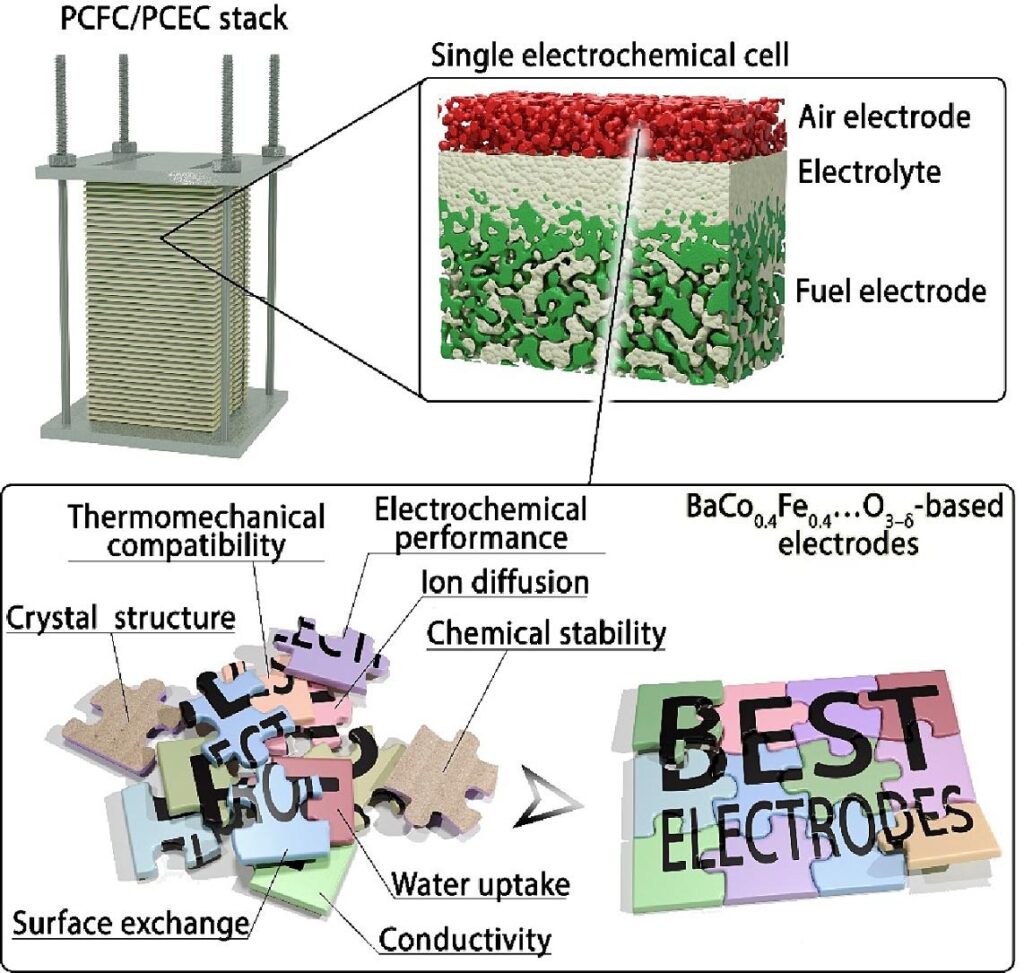
- 08/03/2024: Journal of the European Ceramic Society (IF = 5.7) has published a new work devoted to designing ferrite electrodes with a double perovskite structure for SOFC applications. In the paper entitled ‘PrBaFe2O6–δ-based composites as promising electrode materials for protonic ceramic electrochemical cells’ (https://doi.org/10.1016/j.jeurceramsoc.2024.03.052) PrBaFe2O6–δ was used as a basis for two chemical modification approaches, including doping with cobalt, nickel and copper, as well as composite design with the addition of a BaCe0.8Sm0.2O3–δ phase. The single-phase and composite materials were successfully prepared and characterized in terms of their functional properties. The two approaches were found to synergistically affect the functional properties of PBF, allowing a trade-off between thermomechanical and transport properties to be achieved. As a result, the prepared 70 wt% PrBaFe1.9M0.1O6–δ (M = Co, Ni, Cu) + 30 wt% BaCe0.8Sm0.2O3–δ composites exhibit acceptable electrochemical activity in the intermediate-temperature range.

- 08/03/2024: A new paper has been published in the Ceramics International journal (IF = 5.2), https://doi.org/10.1016/j.ceramint.2024.03.112. The work ‘Tailoring the defect structure and functional properties of Pr2NiO4+δ via partial Pr-substitution with lanthanum and neodymium’ reports the improvement of the functional properties of Pr2NiO4+δ by substituting Pr-cations with isovalent La- and Nd-ions. Based on the experimental data obtained, two optimized compositions (Pr1.5La0.5NiO4+δ and PrLa0.5Nd0.5NiO4+δ) are identified for their further application in electrochemical cells. It is important to note that this research was carried out within the framework of the “Scientific Heights-2023” competition for young scientists, which was held at the IHTE last year.
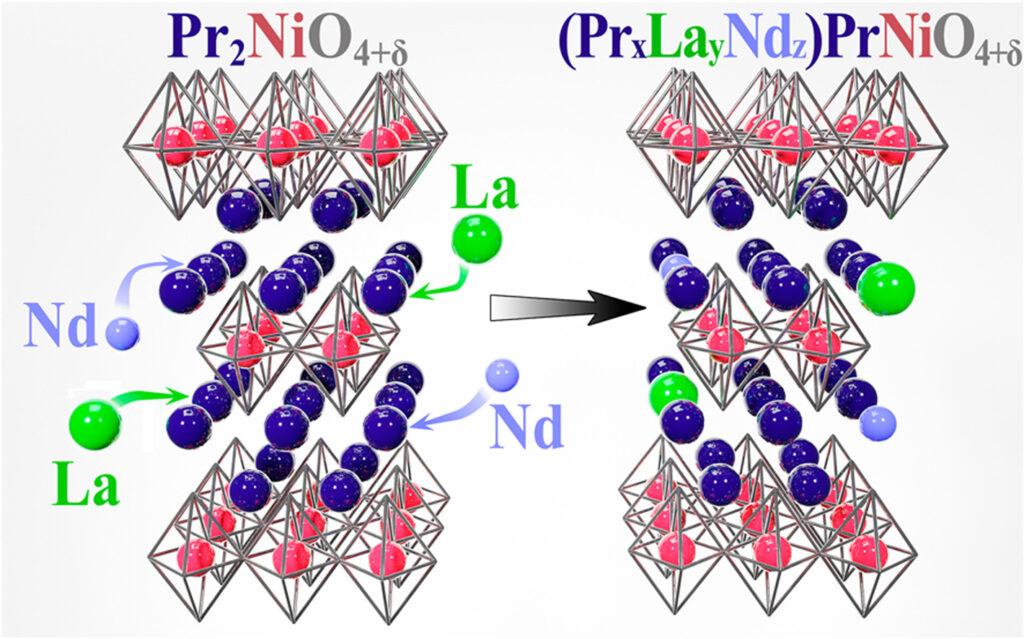
- 08/03/2024: The Journal of Energy Chemistty (IF = 13.1) has published a new review paper entitled ‘Current and further trajectories in designing functional materials for solid oxide electrochemical cells: A review of other reviews’ (https://doi.org/10.1016/j.jechem.2024.02.047). This review is one of the most comprehensive works in the field of solid oxide materials and related eletrochemical cells. The literature review shows that this field has a significant level of research engagement, with over 8,000 publications published since 2020. The manual analysis of such a large volume of material is challenging. However, by examining the review articles, it is possible to identify key patterns, recent achievements, prospects, and remaining obstacles. To perform such an analysis, the present article provides, for the first time, a comprehensive summary of previous review publications (453 items) that have been published since 2020.

- 19/02/2024: A new paper ‘Ba-doped Pr2NiO4+δ electrodes for proton-conducting electrochemical cells. Part 3: Electrochemical applications’ has been published in the International Journal of Hydrogen Energy (IF = 7.2), https://doi.org/10.1016/j.ijhydene.2024.02.173. This is the last part of our research devoted Ba-containing nickelates. Layered nickelates, Ln2NiO4+δ, are promising electrode materials for many electrochemical applications, including solid oxide fuel cells and electrolysis cells. Although Ln2NiO4+δ has been extensively modified by various doping strategies to tune its functional properties, the partial substitution of Ln3+ with Ba2+ remains among the least studied routes. At the same time, such substitution is found to be favorable when Ln2NiO4+δ materials are used for protonic ceramic electrochemical cells based on Ba-containing proton-conducting electrolytes (i.e., BaCeO3, BaZrO3, Ba(Ce,Zr)O3). In this work, which is the third part of a systematic study, Pr2–xBaxNiO4+δ materials are used as electrodes for a proton ceramic fuel cell and as oxygen permeable membranes.
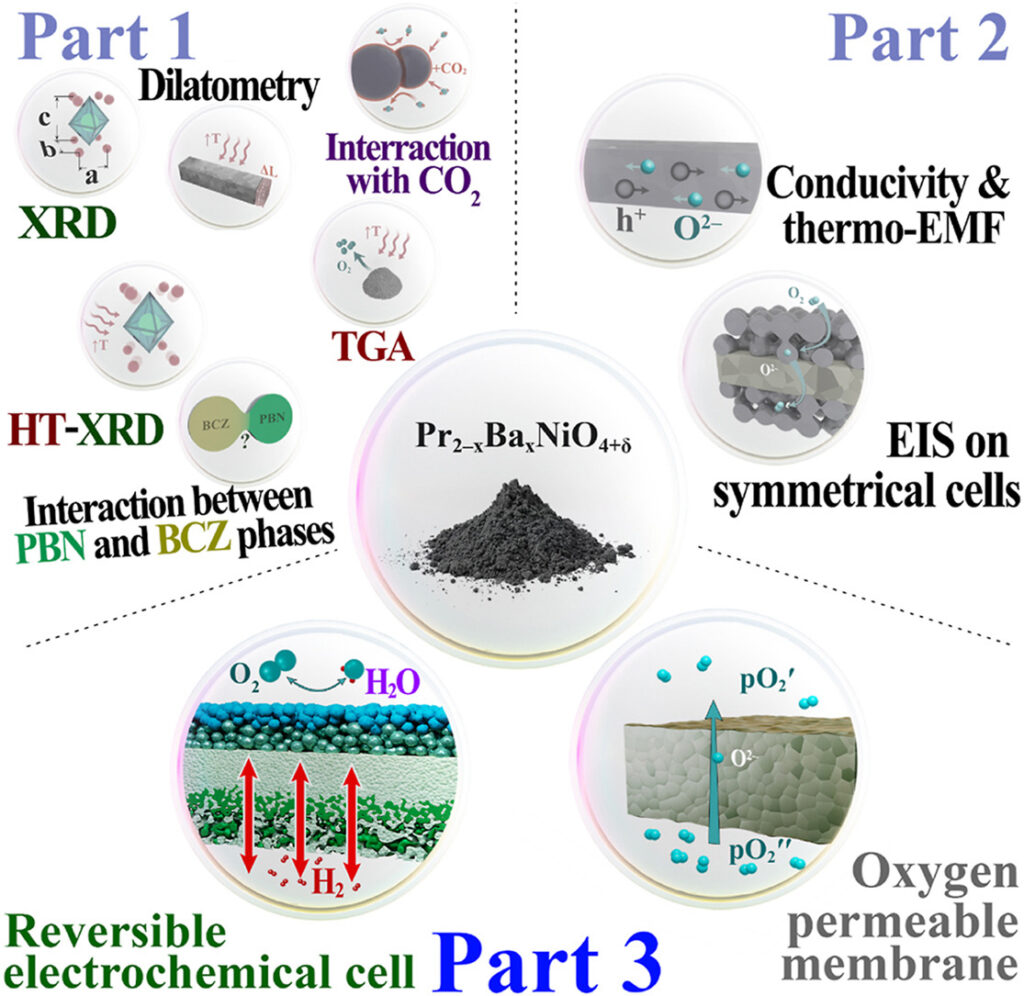
- 05/02/2024: The Advanced Functional Materials (IF = 19.0) journal has accepted our article “Insight into grain and grain-boundary transport of proton-conducting ceramics: A case report of BaSn0.8Y0.2O3−δ” (https://doi.org/10.1002/adfm.202307316) prepared in a collaboration with D. Osinkin as a Head of the Laboratory of Kinetics of our Institute (https://ihte.ru/?page_id=18137, https://orcid.org/0000-0001-6396-8551) and also with colleagues from the The Hong Kong University of Science and Technology and the HKUST Shenzhen-Hong Kong Collaborative Innovation Research Institute. This work is devoted to a detailed study of bulk and grain boundary transport in proton conductors (BaSn0.8Y0.2O3−δ as an example) with the simultaneous determination of the ionic and electronic components of conductivity. Using a unique setup, the main reqularities in the bulk and grain boundary conductivities of the studied object were obtained for the first time over wide ranges of temperatures, oxygen partial pressures, and water vapor partial pressures. A detailed analysis of the impedance spectra using the relaxation time distribution method (EIS+DRT) revealed the presence of two types of grain boundaries: “pure” grains with high ionic (protonic) conductivity and low-conductive grains coated with copper oxide (used as a sintering additive to obtain high-density ceramics). These results are important from the viewpoint of designing functional ceramics with a controlled level of ionic conductivity for their further application in protonic ceramic electrochemical devices.
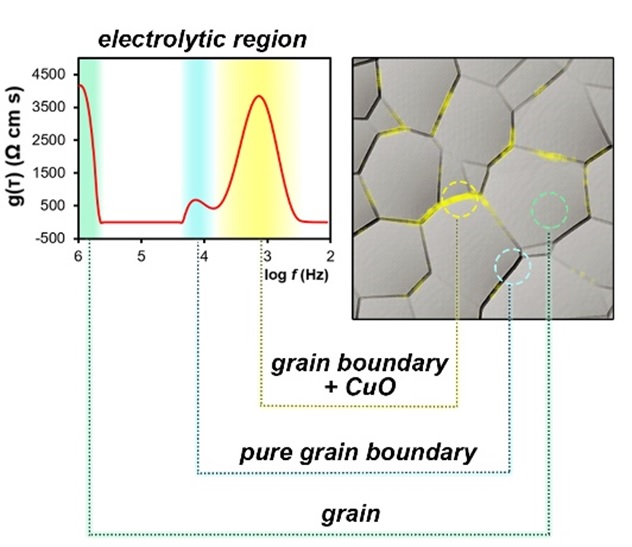
- 19/01/2024: A new work ‘Theoretical and experimental explored tailored hybrid H+/O2– ions conduction: Bridged for high performance fuel cell and water electrolysis’ (https://doi.org/10.1016/j.cej.2024.148750) has been published in the Chemical Engineering Journal (IF = 15.1). This paper deals with a multi-doped cerate-zirconate material as a promising basis for designing the highly conductive proton-conducting electrolytes.
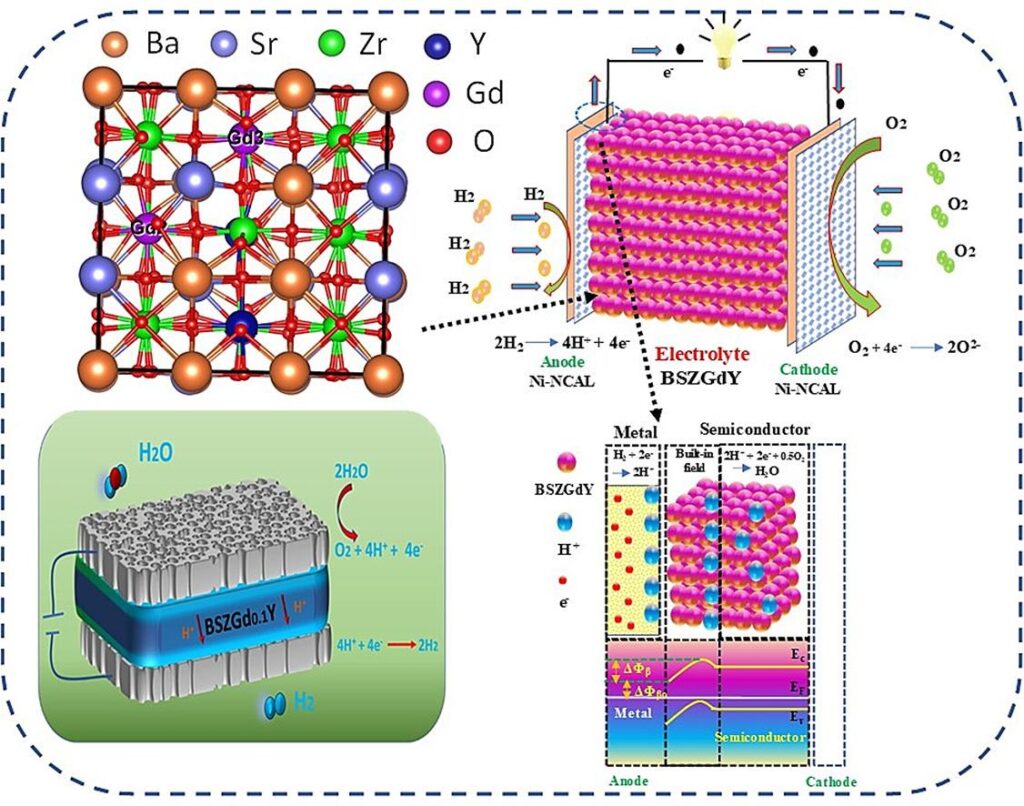
- 01/01/2024: International Journal of Hydrogen Energy (IF = 7.2) has published a review paper entitled ‘Fluorine-insertion in solid oxide materials for improving their ionic transport and stability. A brief review’ (https://doi.org/10.1016/j.ijhydene.2023.08.074). This review covers the recent achievements in the design of fluorine-containing solid oxide materials that can be used as electrolytes or electrodes in solid oxide fuel cells. Usually, tailoring the functional properties of such compounds is realized through a cationic-type doping strategy, when a partial substitution of basic cations with impurity ions is performed. Typically, such a doping improves some properties, but deteriorates others due to significant changes in the cationic framework of a crystal. Anionic-type doping is an alternative way to leave the cationic sites unchanged, which may be suitable for achieving a compromise between a variety of properties. In this brief review, we summarize the existing data devoted to the F-doping (or F-insertion) of solid oxide electrolyte and electrode materials. In most cases, the F-doping improves the chemical stability of compounds and their ionic transport properties. Possible reasons responsible for this improvement are briefly discussed. In addition to highlighting these advantages, possible drawbacks are also listed to stimulate further research activities on this problem.
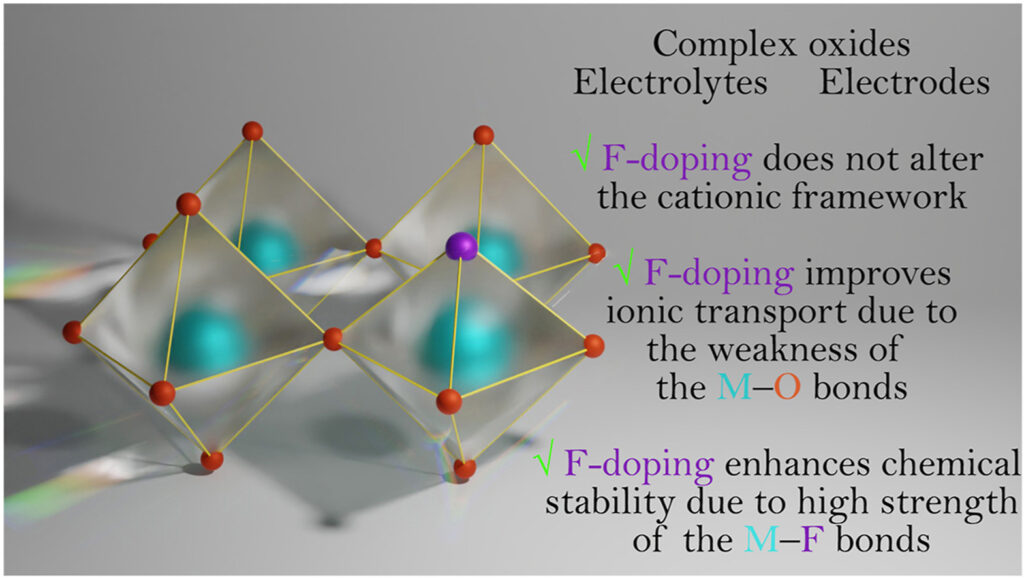
News archive

















